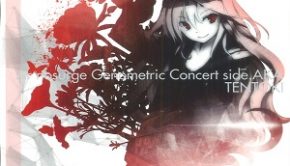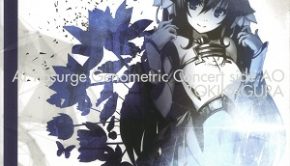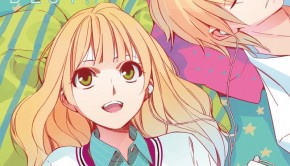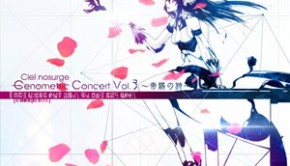Atelier Shallie -Alchemists of the Dusk Sea- Original Soundtrack
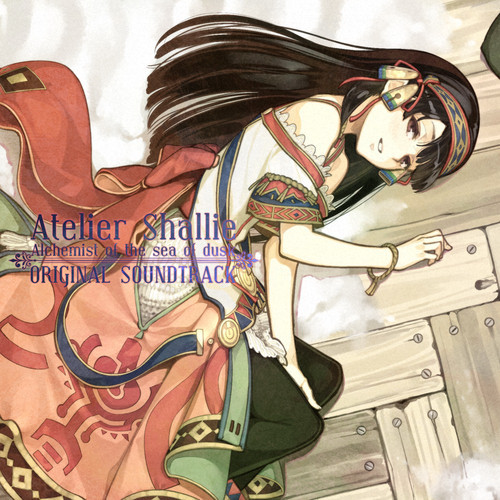 |
Album Title: Atelier Shallie -Alchemists of the Dusk Sea- Original Soundtrack |
| Record Label: Gust |
|
| Catalog No.: GUSTCD-10015/7 |
|
| Release Date: July 16, 2014 |
|
| Purchase: Buy at CDJapan |
Overview
For the release of the 16th game in the Atelier series, Gust also released two albums that contain the instrumental and vocal music of the game, this review focusing on the instrumental songs featured in the original soundtrack. However, this time it features a small group of musicians: familiar composers Kazuki Yanagawa and Daisuke Achiwa, and relative newcomer Hayano Asato, who previously worked in some of the songs for Atelier Escha & Logy: Alchemists of the Dusk Sky and Atelier Rorona Plus: The Alchemist off Arland. Given the lack of prominent composers, does this soundtrack stack up well against its predecessors Ayesha and Escha & Logy? Or does it fall flat due to a lack of a more varied sound?
Body
The music in Atelier Shallie is stylistically very similar to the one composed for Atelier Ayesha, featuring a strong European-folk sound with some orchestral and rock pieces sprinkled about, as the composers involved were pretty much the same ones between both games. The only difference is that Yu Shimoda was replaced with Hayano Asato, so while some of the harder-rock and electronica styled themes disappeared from the music selection due to this, Asato also brought in some folk sounds of his own that complement pretty well Achiwa and Yanagawa’s own work, which will become apparent as we progress through the review.
As the third game in the Dusk subseries, Atelier Shallie also features two familiar compositions from its predecessors. While fewer in number than the remixed tracks in Atelier Escha & Logy’s soundtrack, the arrangements aren’t very bad. On one hand we have the latest iteration of Wilbell’s theme “A Baby Bird part 3”. Originally composed by Yanagawa and arranged this time by Asato, this version makes widespread use of oboe, pizzicato and flute to make a playful melody that suits very well the character, and I have to add it sounds much less sillier than the version from the previous game and more in-tone with the Ayesha version, most likely to match with Wilbell’s older image. However, the second returning track happens to be a fan-favorite: titled “MARIA ORIGIN”, it’s an instrumental version of the vocal theme that was heard in Atelier Ayesha’s final battle. It serves as returning character Keithgriff’s theme, and while it starts as a sad piano solo, it slowly blooms into a stunning piece featuring mandolin and flute. While Haruka Shimotsuki’s voice made wonders in the original version, I have to say this arrangement Achiwa made of his own song is quite marvelous on its own.
Now going to the soundtrack’s original pieces, the album starts up with a full version of the game’s own opening theme “Rusty Sky”. It’s a slow orchestral ballad composed by Sen and sung by Calu, and it’s quite beautiful. While it has a sad and hopeful sound that gives off the sensation of seeing dusk coming and the first stars appearing in the sky, I have to say the lyrics make for a rather large contrast due to how much they reflect feelings of despair and helplessness, as well as about the inevitability of fate. And while it’s sung in English, apparently Calu’s pronunciation still needs more work, as understanding what she is saying is somewhat hard. Despite this, the song as a whole is certainly a beauty that fits very well the opening cinematic in the game, and it’s my personal favorite among the opening themes of the Dusk subseries. Then we begin with the soundtrack proper with a nostalgic piano piece made by Kazuki Yanagawa titled “Disappeared Water”. It’s quite sad and gives off the feeling that the world has seen better times, reflecting the game’s story of how the seas have dried and turned into deserts. This sets up the player for the rest of the game due to being heard in the title screen and in the character selection screen.
I have to say Yanagawa still keeps himself to the style he has been employing all this time: some pieces feature a folk sound that doesn’t sound very dissimilar to the one Ken Nakagawa employed in older Gust games, while in others he makes use of music boxes, and in others he uses full blown orchestral sounds for the music. A good example of how the first two styles are mixed up is in the piece “Let’s Calmly Talk!” which uses a music box prominently at the start, accompanied by pizzicato, piano and guitar, to then relegate it to a second place and give the spotlight to the guitar around the halfway point. As far a more folk-flavored piece, we have Yanagawa’s offering for the atelier theme this time around: “At the Atelier Where Humming Resounds”, which is more specifically heard in Shallotte’s Atelier. This piece composed by accordion, bagpipes, piano, flutes, guitar, bells and percussion is quite the cheery theme. White it has a calm section where the piano becomes the central instrument; most of the piece has a jovial sound that really gets the player eager to start synthesizing. Similarly, we have Cortez’s theme “The Warrior’s Holiday”, which is a folksy song featuring wood percussion, flute, piano and guitar, and it presents a rather large similarity to some of Ken Nakagawa’s pieces. Though this isn’t the only similarity found between both composers, as the game over theme “Defeated Dreams” has a sound that is almost identical to “Defeated in Battle” from Ar tonelico II: Melody of Metafalica.
For a more relaxed mood, we have the piece for the oasis city of Stellard, the game’s main settlement, which is titled “The City of Abundant Water”. It’s a piano and plucked strings piece that has bongos marking the rhythm, and it really fits the scenery of the city filled with water in the middle of the desert called the Dusk Sea, as well as helping to establish its laid-back atmosphere. And when it comes to orchestra, Yanagawa also did some interesting work with pieces like “Song of the Sand Sea Hunters”, which is an orchestral march with quite the grave sound, and which is heard in the place that serves as the main gameplay hub in the game for requests. And on a more sentimental note, we have “Orgel of Youth” which like the title says, is a simple and emotional music box song. This piece is usually reserved for when the protagonists are reminiscing or thinking about their loved ones.
Yanagawa was also in charge of the “Sweep!” series of songs, which are the normal battle themes for Shallotte’s side of the story. While all versions of the song use the same melody, they are markedly different from each other: Part 1 is a fast-paced and cheery woodwind theme that showcases Shallotte’s bubbly and happy personality that also makes use of some orchestration near the middle, while Part 2 is completely orchestral and features a more grandiose and urgent sound. Finally, Part 3 is more similar to Part 1, but it replaces the woodwind with guitars and gives it a faster tempo. However, more interesting is the theme used for the fight against the Octopus boss, which is appropriately titled “Strike the Octopus!” While it starts as a typical nonsense situation piece made by accordion, it quickly reveals itself to be a fast-paced Spanish-styled song that is composed of guitar, beats, piano, electric guitar and organ, and I have to say Yanagawa also has progressed quite a bit in making battle themes with this song, as there are times in which it sounds similar in style to Daisuke Achiwa’s own themes, which in my opinion are generally the best ones in Gust’s soundtracks.
A little more elaborate is the dungeon theme “Gate of Mirages”, which while starting as a piano arrangement of “Rusty Sky”; its instrumentation changes to consist of mandolin, flute and music box after a little while. It still conveys the same feelings as the original song, though it also has stronger feelings of loneliness and sadness in it. A choral arrangement of the final part of “Rusty Sky” is also heard in the form of “Automata Song”, which while starting as a bunch of dissonant synthesized voices, after a while they join to cohesively form the beautiful melody from the opening. However, Yanagawa also reused the main melody from the song in the action theme “The Ones Challenging the Dusk”, which starts orchestral to then give space to a flute and strings before building up through a short bagpipe and piano section to then crescendo and loop back at the beginning. While it’s a bit surprising to find such a tranquil melody in a more intense piece, I have to say it sounds pretty well combined with the rest of the song.
About the other dungeon themes, we have the tribal and fast-paced “Stop the Sand Dragon!”, the uplifting and somewhat mysterious flute-based “Sleeping Vines” , the whimsical and fun “Crystal Dance”, and the majestic and organ-based “Illusions Shown by the Corals”. However, my personal favorite among them is “Sanctuary of Water”, which is a piano and flute piece accompanied by soft choral singing, harp and droplet sounds, which gives the impression of really being inside an enormous palace that has waterfalls and channels flowing all around, though the place it plays in the game is actually completely dry and deserted. And while I really like it, I have to admit that when it comes to sound, it’s like a more mysterious and less emotional version of “The Warmth Conveyed by the Water” from Ar nosurge: Ode to an Unborn Star.
Finally, Yanagawa also contributed some of the snippets for the special skills of the characters Shallotte, Wilbell, Cortez and Homura. They are respectively “FJ: Burning Flam”, which has a flamenco sound to it; “FJ: Secret Arts”, which is a techno piece that wouldn’t be out of place in a magic show; “FJ: Divine Hammer”, which is orchestral and adventurous; and “FJ: Hom-Style Peerless Greatsword”, which is a rock piece that also features accordion. Suffice to say they all match pretty well their respective characters.
Now going on to Daisuke Achiwa’s contributions, the first thing I have to note is that he made all the world map themes this time around, which are the “Sand Sea” series of songs. The main one changes depending on the character the player picked at the beginning, which is why the first two are “Sand Sea –Shallistera-” and “Sand Sea – Shallie-”, and though they are near identical, they can be differentiated by the fact the first uses a guitar for the harmonics and some light singing, while the second uses an accordion, as well as the fact they both use different flutes. However, the other arrangements, which are used for the roads interconnecting the areas in the world map, make more of an effort to differentiate from each other: “Sand Sea –Desert-” is formed by piano and sitar; “Sand Sea –Plants-” has a slower tempo and is formed by an orchestra and piano; “Sand Sea –Ruins-” has a sadder sound and is purely played by guitars until a mandolin and strings kick in, “Sand Sea – Trade Area -” has a more irregular rhythm and is played by a guitar and synthesizer; and “Sand Sea –Cave-” has a majestic sound made up of strings, oboe and crystalline sounds. It’s also interesting to mention how the game transitions seamlessly between two songs of this series when the player moves from the world map to one of the areas where they play.
Moving on, Achiwa has composed a few of the silly themes for the game, such as “I Don’t Get It” and “Umm, Err… I Think”, both of which are formed by a tuba, a brass ensemble, strings and xylophone, and listening to them only makes me want to place my hand on the forehead and laugh, though I feel the latter could have used some more development. Of more interest are “Bursting March”, which seems to use several ideas from the Spanish-styled pieces, and “Seeker’s Tango”, which as the name says is a tango that sounds so serious that it ends up becoming funny (I guess it’s due to being the theme of returning character Harry this time around).“Great Derailment March” harkens us back to the times of Atelier Iris: Eternal Mana due to its similarity with the track “Operation Popcorn”, though it has a grander and more serious sound. We also have “Attractive Beach Queen”, which thanks to the instrumentation; it makes a good job of setting the mood for the Water Festival, which is the point in the game where the CG of all the female characters playing in the water and wearing swimsuits is shown. And there’s also the funny-sounding but enjoyable and cheerful “The Blue Sky and the Broom Girl”, which consists of strings and a trumpet and serves as the main theme for the more excitable of the two main girls: Shallote.
On the folk front, we have the bouzouki, mandolin and flute-based “The Girl of the White Sands” that serves as Shallistera’s theme and it’s a soft and beautiful theme that showcases her shy and gentle personality. There is also the more playful and cheerful “We’re Both Shallie”, which while sharing a similar instrumentation to the previous piece, it also adds an accordion, which shows the atmosphere when both protagonists are working together;. Also worth mentioning is the serious and heroic “Flame”, which is the theme for the character Homura, and it uses an orchestra and a flute to carry on a majestic melody. We also have the more sentimental and soothing “The Twilight and the Hourglass”, which is a flute and piano duet that gets joined by strings and a harp. It’s quite a beautiful piece, and one that would serve well when one needs to wind down, especially due to how it ends as a soft piano solo, even though the strings come up again for a couple seconds. On that same vein, we have “Open the Door”, which while having a similar instrumentation to the previous piece, has a slower tempo and a sadder sound. “Droplets of Time” begins as a simplistic sad piano solo to later on bloom into a beautiful and moving orchestral song, though melodically I have to say it reminds me a lot of “Elegy” from Ar tonelico: Melody of Elemia.
And we couldn’t forget the reason why Achiwa’s so known among Gust’s composers, which is the battle themes: “Scorpio” is a more hard-rock styled one, featuring roaring electric guitar riffs, while “Aquarius” is a rock-folk mix where the electric guitar takes a backseat to the flute. Achiwa also made the battle theme that can be heard during the first phase of the final battle: “Tsunami”. Appropriately starting with tidal wave and water droplet sounds, it then has a lone voice singing over an orchestral backdrop, until an electric guitar kicks in. While it could be considered a bit subdued for the role it plays due to its slow rhythm, I still think the song is quite beautiful and a great way to start the game’s final fight, at least until the second phase begins and “Luto –The Ruling One-“ from the vocal album replaces it.
And now we go over to check on the work of the newcomer composer Hayato Asano. While I wasn’t very impressed with the work he did in Ciel nosurge’s unreleased tracks or in Ar nosurge’s Red Genometric Concert, here he showed off a much better composition and arrangement work. Asato contributed the second atelier theme “The Alchemist Aboard the Ship”, which is a soft and playful guitar, accordion and flute piece used when the player is in Shallistera’s Atelier. In contrast to Shallotte’s more bouncy theme, this one brings out Shallistera’s more tranquil personality. He also contributed a rather unusual piece for the tutorial theme: it’s a folk-march featuring flute and violin that feels pretty fun to listen and makes tutorial much more enjoyable to read, though it might just because I got so used to slower and more mechanical pieces being used for such a purpose. Too bad the recipe learning theme “Memorize!” doesn’t follow the same steps and instead quite a repetitive song… However, he also did a good job with the second town theme. This piece is called “Red Light” and it can be heard in Farv Village; and in contrast with Yanagawa’s offering, this one starts as a mysterious piano solo, but quickly becomes an energetic strings and flute song that is filled with wonder, reflecting the feelings of the protagonists on realizing how large the world is when they first arrive at it.
Carrying on, Asato also made the “Stella” series of battle themes, which are heard in normal battles when the player is playing Shallistera’s side of the game. Like with Shallotte’s themes, there are three parts to them: Part 1 is a piano and flute-based theme with some accordion and xylophone parts that pumps the player up despite having a somewhat relaxed sound. Part 2 features tolling bells and electronic sounds alongside a violin playing the main melody, and while it features a calm section, it has a more exciting way of finishing before looping back. Finally, Part 3 is more rock-styled, featuring an electric guitar on the main melody and played at a faster tempo, and it makes for quite an exciting arrangement that tells the player they are really getting close to the game’s end. And even more exciting is the rock-orchestral theme “Flying Clouds, Drifting Haze”, which is heard during the battle with the Sand Dragon. Starting with a sweeping group of strings, led by piano and electric guitar, it calms down for a bit to let the violin take the center stage to then let both the orchestra and the guitars crescendo. This makes it for quite an excellent battle theme for the first of the game’s important boss battles.
And on a similar topic, Asato’s dungeon themes are a nice listen too. “Seeing off the Daytime Calm” is played on the first dungeon, and it’s a fun piano and guitar piece that adds a flute after a bit, which players get to hear as they settle down learning how the game is played. “Shining Zoospore” features a mysterious and lonesome piano and flute intro before rising into a nice orchestral climax and ending as mysteriously as it began, while “Within the Feelings Left Behind” is a sad guitar, piano, strings and oboe piece that brings to mind the regrets that keep ghosts attached to the living world due to being heard in a ghost ship. The remainder of the special skill snippets where also his contributions: the heroic orchestral “FJ: Initiate Flam” for Shallistera; the pop-rock “FJ: Full-Auto” for Miruca; the funny and chase-like” FJ: Fatal Blow” for Yulie; and the electric guitar and piano “FJ: Hand of Dusk” for Keithgriff. However, I feel this one clashes a bit with the more jazzy and elegant “FJ: Ancient One” he had in Atelier Ayesha.
Aditionally, matryoshka composer Sen also brings us “Narcolepsist”, which is the theme for the Eternal Throne, the final dungeon. It’s somewhat hard to describe this piece due to its length, but I find the most appropriate word for it would be “upsetting”, in the sense of creeping out or scaring the player. Featuring piano, harp, choir, electric guitar and strings, I can say this piece starts depressing and lonesome, but it begins becoming scarier the longer it goes, and despite having slower sections featuring only the harp or the piano, I can only describe its final parts as apocalyptic due to an abrupt key change preceded by a scratching noise and the way in which the choir intensifies its singing and the rhythm accelerates; not to mention how much it uses warped voices, distortion effects and white noises. This piece is also featured in the vocal album with no changes to it.
Finally, we have the ending themes to the game. There are three possible BGMs prior to the vocal ending theme, which depends on which type of ending the player is getting: those that end the game with Shallistera will hear “The Alchemist Aboard the Ship –epilogue-“, which is a mellow and nostalgic orchestral reprise of the theme arranged by Kazuki Yanagawa. On the other hand, Shallotte players get “At the Atelier Where Humming Resounds –epilogue-”, which is a guitar, harp and bells arrangement made by Daisuke Achiwa, and due to the bells sounding similar to a music box, it does a great job of reminding the players of all the things they did during the game. And those aiming for the True Ending get a reprise of the opening theme in the form of “Rusty Sky –epilogue-”. This one is a warm piano solo reprise of the song’s main melody, which by the halfway mark changes to playing the melody heard in the final sections of the song. In general all of these three times should bring a smile to the players that spent playing the game to the end.
And closing off the album, with the pardon of the FJ themes that I covered previously, we have the ending theme “Last Wanderlust”, once again composed and arranged by Sen and sung by Calu. Starting as a funny pizzicato piece, it slowly adds sounds of singing birds and a ship moving after Calu starts singing, before adding in piano and strings. While at first I was annoyed due to how long it takes to develop and how it goes back to the start after the first refrain, I was pleasantly surprised after seeing it transition into the end, which shifts in pitch and concentrates all the instrumentation and vocals into a calm but fulfilling melody, which ends with the birds chirping, giving the sensation the journey has finally come to an end.
Summary
While for some reason this album felt thicker to me than previous Atelier offerings and thus it took longer for me to get to enjoy it, I have to say I still enjoyed it greatly. While it doesn’t have much of a varied sound in comparison to Atelier Escha & Logy’s soundtrack, it instead provides a more cohesive experience due to its closer focus on a fewer musical styles, and Yanagawa and Achiwa have done an excellent work once again, even if I’m starting to feel Achiwa needs to vary his melodic patterns a little. Sen also did a wonderful work in the few tracks they took part in, and Asato has pleasantly surprised me with the greater sound variety he managed to make here in comparison to his previous two works. Very few tracks feel like filler, or that they weren’t thought out enough, which is why I’m happy to recommend this album and to wholeheartedly agree with Asato’s nomination as Most Outstanding Contribution – Newcomer in the AGMAs 2014.
Do you agree with the review and score? Let us know in the comments below!
4.5
Posted on June 28, 2015 by Gerardo Iuliani. Last modified on June 28, 2015.

